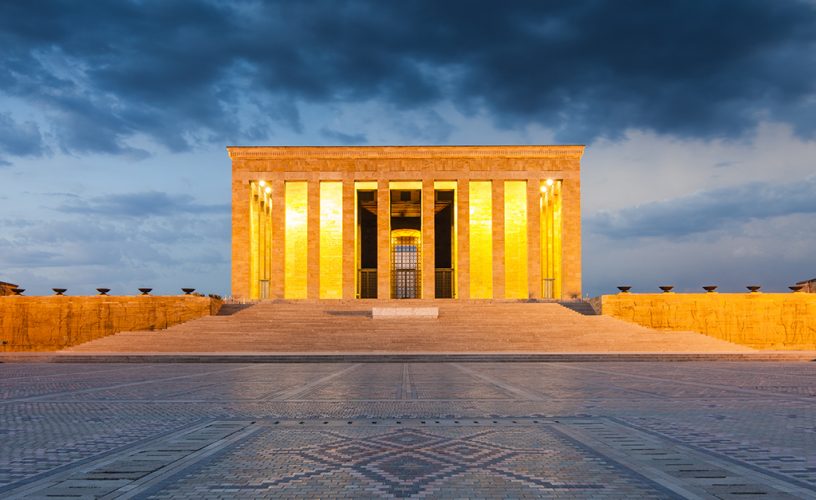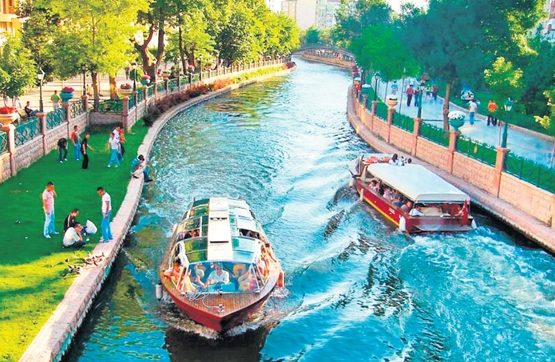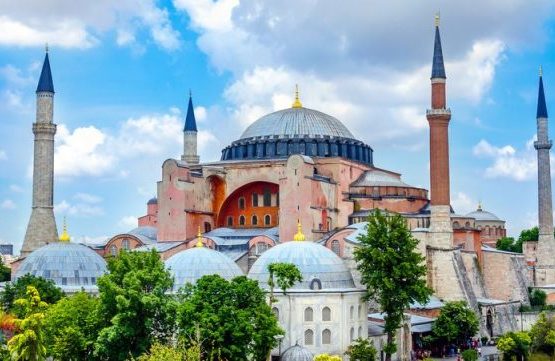ANITKABIR
Mustafa Kemal Atatürk
Located in the heart of Ankara, this mausoleum of Mustafa Kemal Atatürk is reason enough to visit Ankara. Having served as a military officer in the Ottoman Empire, Atatürk led the Turkish National Movement in the Turkish War of Independence after the dissolution of the empire. After leading his troops to victory, Atatürk established a program of reforms in order to turn the former empire into a modern and secular republic. He became the first president of the newly established Turkish Republic in 1923, serving until his death in 1938. It was at this time that plans for his final resting place began as a superior commission.
Anıtkabir (literally, “memorial tomb”) is the mausoleum of Mustafa Kemal Atatürk, the leader of the Turkish War of Independence and the founder and first President of the Republic of Turkey. It is located in Ankara and was designed by architects Professor Emin Onat and Assistant Professor Ahmet Orhan Arda, whose proposal beat 48 other entries from several countries in a competition held by the Turkish Government in 1941 for a “monumental tomb” for Atatürk.
The site is also the final resting place of İsmet İnönü, the second President of Turkey, who was interred there after he died in 1973. His tomb faces the Atatürk Mausoleum, on the opposite side of the Ceremonial Ground.
The site chosen for Anıtkabir was known as Rasattepe (Observation Hill), which, at the time of the architectural competition for Anıtkabir, was a central location in Ankara and could be seen by all parts of the city. Archeological excavations unearthed artifacts belonging to the Phrygian civilization, which were carefully excavated and put on display in the Museum of Anatolian Civilizations, also in Ankara.
Archıtectural Features
Anıtkabir consists of four separate sections;
In the First Section: It was made the adjustment of land level for the tomb. Additionally, the Reliance Wall (Istinat Duvarı in Turkish) was built on the lion road leaning down Ataturk’s mausoleum. It was completed in one year.
In the Second Part: It covers the area of tomb, ceremony and around buildings added later. Also the project of monument’s mass had been planned within that place. Entry towers and an important section of that fascinating organization were finished here. Surrogated by many various trees such as Acacias, Ash Threes, Elm, Honeysuckle, Silverberry and Tamarisk Trees, that location contains the water system which creates a ravishing atmosphere. It takes 5 years.
In the Third Place: The roads meeting the monument and Lion Road were finished in that space. The Parade (Ceremony) Ground and the tomb were furnished here. Moreover, the steps of stairs were made in that location.
The Last Section: It is the last grade of the building breath-taking Anıtkabir. Honour Hall and the vaults were built here. That part was ornamented with the amazing stone profiles and eaves motifs which reflect Seljuk and Italian architectural syles.
Road of Lions
When you step into the Ataturk Mausoleum, you will see 24 lion sculptures on the each two sides of the road. Those fascinating lions symbolize both 24 Oghuz Tribes and the power. They also reflect the union of Turkish people. But most interesting thing is there are found the lions with the head bent around that tomb.
Located on the Anıtkabir, that glorious museum consists of Ataturk’s shave sets, sticks, gifts and other his possessions like many photographs about him and his valuable family. In addition to this, the weapons of famous Sabiha Gökçen (the first woman combat pilot) and Afet İnan (foster child of Ataturk) and the mini Koran belonging to Rukiye Erkine (another adopted daughter of him) given by Ataturk as a present were exhibited here.
Moreover, there is found a special library of him. One of the most important books in here is surely ‘’Nutuk’’. Among of the other books are Turk and Islam History, Literature, Social Sciences, Turkish, Ottoman Turkish, French, English, German, Russian, Arabic, Persian, Slavic Books. Totally 3115 books are found here.
SALT LAKE
Lake Tuz (Turkish: Tuz Gölü meaning Salt Lake) is the second largest lake in Turkey with its 1,665 km2 (643 sq mi) surface area and one of the largest hypersaline lakes in the world.
If there’s a single landscape near Ankara that begs to touched, felt, and seen, it’s the geological oddity known as Lake Tuz. One of the largest salt lakes in the world at over 1500 square km (580 square miles), the lake is the center of industry in the region that exists producing an incredible two-thirds of the salt consumed in Turkey.
A huge expanse of a beautiful salt lake that you are able to walk on!
Because there is a little bit of water amongst the large salt granules, you get incredible reflections as you walk across it, which meant we had a lot of fun for photos.
A popular birdwatching area. A protected area since 2001 due to the fragile and unique ecosystem that supports creatures like the Greater Flamingo and Greater white-fronted goose, this body of water is an interesting visit during all seasons. In winter months the lake is quite shallow and can be waded in (although we strongly suggest wearing some sort of waterproof footwear), while it can completely dry up in the summer heat, leaving a hard crust of salt for travelers to walk on. There aren’t really any official hikes, but it is worth trekking out to Büyükada Island, where a Romanesque church still stands.
MUSEUM OF ANATOLIAN CIVILIZATIONS
The first museum in Ankara was founded at the tower of castle, named Akkale in 1921 by the Director of Culture Mr Mübarek Galip. Besides this museum, the works were also collected in Augustus Temple and Roman Bath. When the Hittite Works in surrounding cities began to be sent to Ankara with the idea of Atatürk establishing a “Hittite Museum” in the centre, a museum building with a large area was necessary. Mahmud Pasha Bazaar and Kursunlu Inn, in deserted and ruined state, was suggested to be used as museum complex by Mr Hamit Zübeyr Koşay, the Director of Culture of that time, to Mr Saffet Arıkan, Vice-Ministry of Education of that period. Upon being approved, the complexes went into restoration between the dates 1938 and 1968. With the completion of most parts of vaulted hall in the middle of bazaar in 1940, the pieces began to be placed. While the reparation of buildings continued in 1943, the middle section of the museum was opened to public visits. In 1948,
The Anatolian Civilizations Museum, being among exceptional museums with its unique collection, has Anatolian archaeological artefacts and artefacts from the Palaeolithic Age to the present.
The exhibits of gold, silver, glass, marble and bronze works date back as far as the second half of the first millennium BC. The coin collections, with examples ranging from the first minted money to modern times, represent the museum’s rare cultural treasures.
Museum of Anatolian Civilizations reaching the present time with its historical buildings and its deeply rooted history was elected as the first “European Museum of the Year” in Switzerland on April 19, 1997.
Ancient Jewellery is exhibited in the Anatolian Civilizations Museum.The Museum of Anatolian Civilizations has eight distinct sections, following a chronological order, filled with precious artifacts that shed light on Turkey’s ancient history. The first section features findings from the Paleolithic Age (before 8000 B.C.), including stone and bone tools used by hunter and gatherer communities that lived in caves. Neolithic Age (8000–5500 B.C) artifacts display the beginning of food production and settlements by the communities that lived in the era. Among the objects are sculptures of mother goddesses, stamps, earthenware, and tools made of bone.
Palaeolithic Age (….8000 BC): The Palaeolithic Age is represented in the museum by the finds uncovered in the Antalya Karain Cave. People of the Palaeolithic Age were hunter-gatherers who used stone and bone tools. The stone tools are displayed under three time categories: Lower Paleolithic Age, Middle Paleolithic Age and Upper and Late Upper Paleolithic Age.
Neolithic Age (8000-5500 BC): During this age, the first villages appeared and agriculture began. The artifacts from Çatalhöyük and Hacılar, which are two of the most important sites of the Neolithic Age, are exhibited in this section. The collection includes Mother Goddess sculptures, wall paintings, clay figurines, stamps, earthenware containers, and agricultural tools made from bones. The most impressive parts of this exhibit are a hunting scene on plaster from the 7th millennium BC, a reproduction of a Çatalhöyük room with wall-mounted bull heads, a Mother Goddess Kybele (later Cybele) sculpture, obsidian tools, wall paintings of Mount Hasan erupting, and wall paintings of a leopard.
Chalcolithic Age (Copper-Stone) (5500-3000 BC): In addition to stone tools, copper was processed and used in everyday life during this age. The artifacts recovered in Hacılar, Canhasan, Tilkitepe, Alacahöyük and Alişar Hüyük are exhibited in the museum. The collection includes a large collection of stone and metal tools, goddess figurines, seals, and decorative jewelry.
Old Bronze Age (B.C. 3000-1950): The people living in Anatolia in the beginning of the 3rd millennium B.C. added tin and alloy to copper and invented bronze. They also worked all metals of the age with casting and hammering techniques. Valuable metals, magnificent death presents discovered from royal tombs of Alacahöyük, ruins from Hasanoğlan, Mahmatlar, Eskiyapar, Horoztepe, Karaoğlan, Merzifon, Etiyokuşu, Ahlatlıbel, Karayavşan, Bolu, Beycesultan Semahöyük, and Karaz-Tilki Hill constitute the rich Old Bronze Age and are exhibited in the museum.
Hittites (B.C. 1750-1200): The first political union in Anatolia in the 2nd millennium was established by the Hittites in the Kızılırmak basin. The capital city was Boğazköy (Hattuşaş) and other important centres were İnandık, Eskiyapar, Alacahöyük, Alişar, and Ferzant. Embossed bull figure containers, earthenware artefacts, tablets of government archives, seals in the name of the king can be seen.
Phrygian Period (1200-700 BC): The Phrygians, the so-called Sea People, came to Anatolia from the Balkans in 1200 BC. They acquired control over Central Anatolia and made Gordion their capital city. The finds from the royal tumulus at Gordion form the majority of this section. The tumulus measured 300 m (980 ft) in diameter and 50 m (160 ft) in height. The reproduction of the tomb of King Midas, found in the ancient tumulus, is also displayed here. Carved and inlaid wooden furniture, hinged dress pins, ritual vessels, depictions of animals such as lions, rams and eagles, the reconstruction of a burial ceremony and the statue of the Mother Goddess Kybele (to whom the Phrygians worshipped as their main deity) are represented in this section.
Urartu (B.C. 1200-600): The Urartu civilisation reached an advanced architecture and mining technology in centres like Altıntepe, Adilcevaz, Kayalıdere, Patnos, Van, Çavuştepe and lived during the same period as the Phrygians.
Lydian Period (1200-546 BC) : The origin of Lydian art comes from the Bronze Age in which there were relations, friendly or hostile, between their ancestors and the Hittites. Lydians made spectacular progress in the Iron Age, especially from Gyges period to Croesus (685 to 547 BC). The exhibited artifacts mostly date from the 6th century BC.






